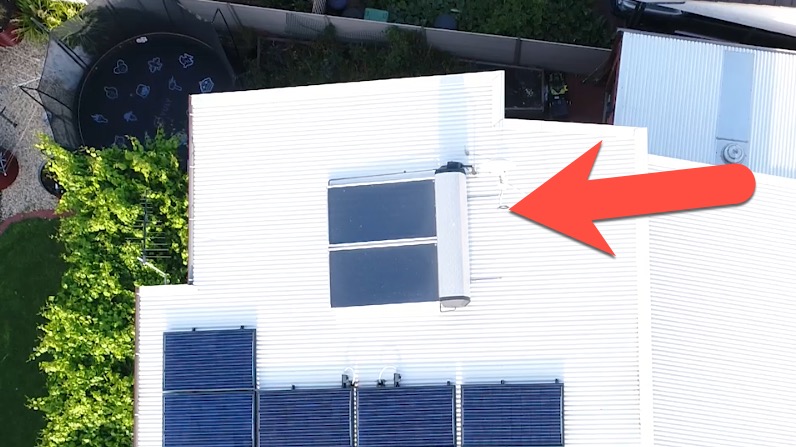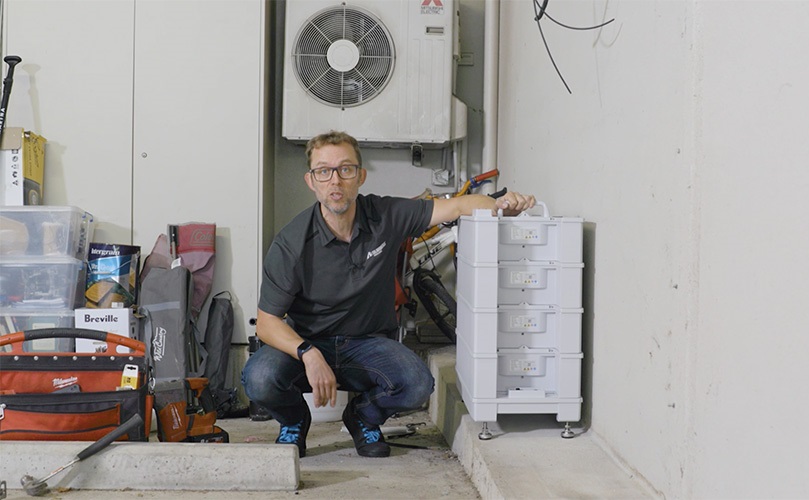Common Ways To Power Your Home With Solar Energy
Solar Basics: Types Of Solar Energy
Ten years ago there were two main ways for homes to harness the power of the sun:
- Solar thermal hot water – usually just called solar hot water
Or
- Solar photovoltaic – or solar PV for short.
While you can still see older solar hot water systems on roofs, they’re rarely installed these days. This is because they’re no longer cost effective. Solar PV has fallen in price while solar hot water hasn’t. This makes it considerably cheaper to now run a hot water system with electricity from solar PV.
Solar PV can provide a household with energy during the day and allows a hot water system to act like a battery by storing energy for use after the sun goes down. But, these days, actual home batteries are becoming more common and allow the use of solar generated electricity 24 hours a day.
What They Look Like
The picture below has a big red arrow pointing to a solar thermal hot water system. Below it are solar PV panels.

This solar hot water system has flat plate collectors, which is the most common type. Some have glass tubes instead. Here the storage tank is on the roof but it can be located on the ground.
Hot Water From Solar PV
Solar hot water is now usually only installed if there are special circumstances. The special circumstance can simply be, “I really like solar hot water.” That’s an excellent reason to get it.
When using the lower cost method of using solar PV to heat water, there are three main ways to maximize savings:
- Put a conventional electric hot water system on a timer so it turns on during the day when your solar PV generates electricity. Because timers are cheap this has the lowest upfront cost.
- Spend around $1,000 or more get either a PV hot water diverter or a relay that sends surplus solar energy to a conventional electric hot water system.
- Get a heat pump hot water system. Despending on how much you’re willing to spend, these only use around one-third to one-fourth as much energy as a conventional electric hot water system. They can also be put on a timer so they turn on during the day. This has the highest up-front cost but saves the most energy over time.
A heat pump is the most energy efficient option, but they’re not cheap – especially the higher quality ones I recommend getting. This means you’re better off buying a large solar system and sticking with a conventional electric hot water system rather than getting a small solar system and having enough money left over to get a heat pump.
Solar + Battery
Solar PV only generates electricity during the day. The word “solar” in the name is a big hint about when it provides power. A household can increase the amount of energy they get from the sun by shifting electricity consumption to the middle of the day. Having hot water systems turn on at this time is one way of doing this. But an increasingly popular way for households to increase the amount of solar energy consumed is to install a battery.

Finn next to a yet to be installed 12.8 kilowatt-hour Sungrow home battery.
A battery can allow most of a home’s electricity consumption to come from its own solar panels. The drawback is, at this time, batteries aren’t cost-effective for most households. But a battery may save you money if you live in NSW, QLD, SA, or WA and have above-average evening electricity consumption. Even if you don’t expect to come out ahead financially, you could still consider them worthwhile because they can potentially provide backup power during blackouts.
The 2 Modern Ways Of Powering Your Home With Solar
Because solar hot water is no longer cost-effective compared to solar PV, there are now two main ways of powering your home with solar:
- Solar PV only: This provides power during the day, and surplus solar energy can be exported for a feed-in tariff.
- Solar PV & Battery: This provides power during the day and surplus energy can be stored in the battery for overnight use, with any remaining being exported for a feed-in tariff.
The first option is worthwhile for almost every home with an unshaded – or even partially shaded – roof. The second – at the moment – will only save money for households with high evening electricity consumption and high electricity rates.